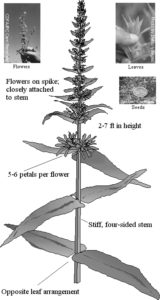Bad and Beautiful, Purple Loosestrife Threatens Norfolk’s Wetlands
By Shelley Harms
Purple loosestrife has been spotted this summer in wet spots along Norfolk roadsides. A showy plant with spikes of magenta flowers, it spreads very rapidly. It can take over large areas, suppressing native plant communities and actually altering a wetland’s structure and function.
Purple loosestrife (lythrum salicaria) is a perennial that can grow ten feet tall and four feet wide. One mature plant can produce more than 2 million seeds annually and can also spread vegetatively, through fallen stems that root. Warm temperatures and open, moist soils are required for successful germination, and seedling densities can approach 20,000 plants per square meter.

Purple Loosestrife, a non-native plant that grows to ten feet tall, invades wetlands and roadsides.
Purple loosestrife moves aggressively into wetlands, eliminating native plants such as cattails, sedges and ferns. As wetlands become infested, food for wildlife is lost and there are fewer nesting places for birds like bitterns and rails. The plant forms large single-species stands with dense root mats that can even impede the natural flow of water.
Purple loosestrife came from Europe almost 200 years ago, and has spread and degraded America’s wetlands ever since. There are no native control agents. In other words, nothing eats it. Unlike the similar leaves of goldenrods and willows that are full of holes from feeding insects, the leaves of purple loosestrife are pristine and undamaged. Sale and cultivation of purple loosestrife has been banned in Connecticut since 2005.
This plant is difficult to control. In the small, localized stands that are appearing in Norfolk, pulling it up and making sure the entire root system is removed is the best way to stop it. Cutting the seed heads off and bagging them will stop those seeds from spreading, but it does not kill the plant, which will produce more seeds next year (maybe even this year – cut stems grow back very quickly). Other control techniques include water-level manipulation, mowing, burning and herbicide application. All these control methods require long-term maintenance.
A program at the University of Connecticut is using beetles to attempt to control the spread of purple loosestrife. Since 1996, more than 1.5 million Galerucella leaf-eating beetles have been released in more than 100 Connecticut wetlands. Feeding injury by the beetles helps to reduce purple loosestrife populations, but does not eradicate the plant. Donna Ellis, who runs the program, says that Norfolk residents should focus on pulling up the plants before they are dense enough to warrant the release of the beetles. “A little loosestrife will become a lot,” she says, unless the small stands we are seeing are nipped in the bud.
Bad and beautiful, purple loosestrife may be here to stay.
